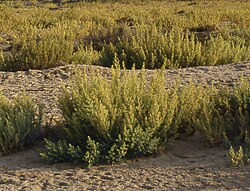| Bienertia | |
|---|---|
 | |
| Bienertia sinuspersici | |
| Scientific classification | |
| Kingdom: | Plantae |
| Clade: | Tracheophytes |
| Clade: | Angiosperms |
| Clade: | Eudicots |
| Order: | Caryophyllales |
| Family: | Amaranthaceae |
| Subfamily: | Suaedoideae |
| Genus: | Bienertia Bunge ex Boiss. (1879) |
| Species | |
3 species, see text | |
Bienertia is a flowering plant genus that currently is classified in the family Amaranthaceae [1] s.l. (including the family Chenopodiaceae). For long time, the genus was considered to consist only of one species, Bienertia cycloptera, but in 2005 and 2012, two new species have been separated.
Species of this genus have acquired an unusual, single-cell type of C4 carbon fixation without Kranz anatomy, also found in some species of the closely related genus Suaeda . [2] [3]